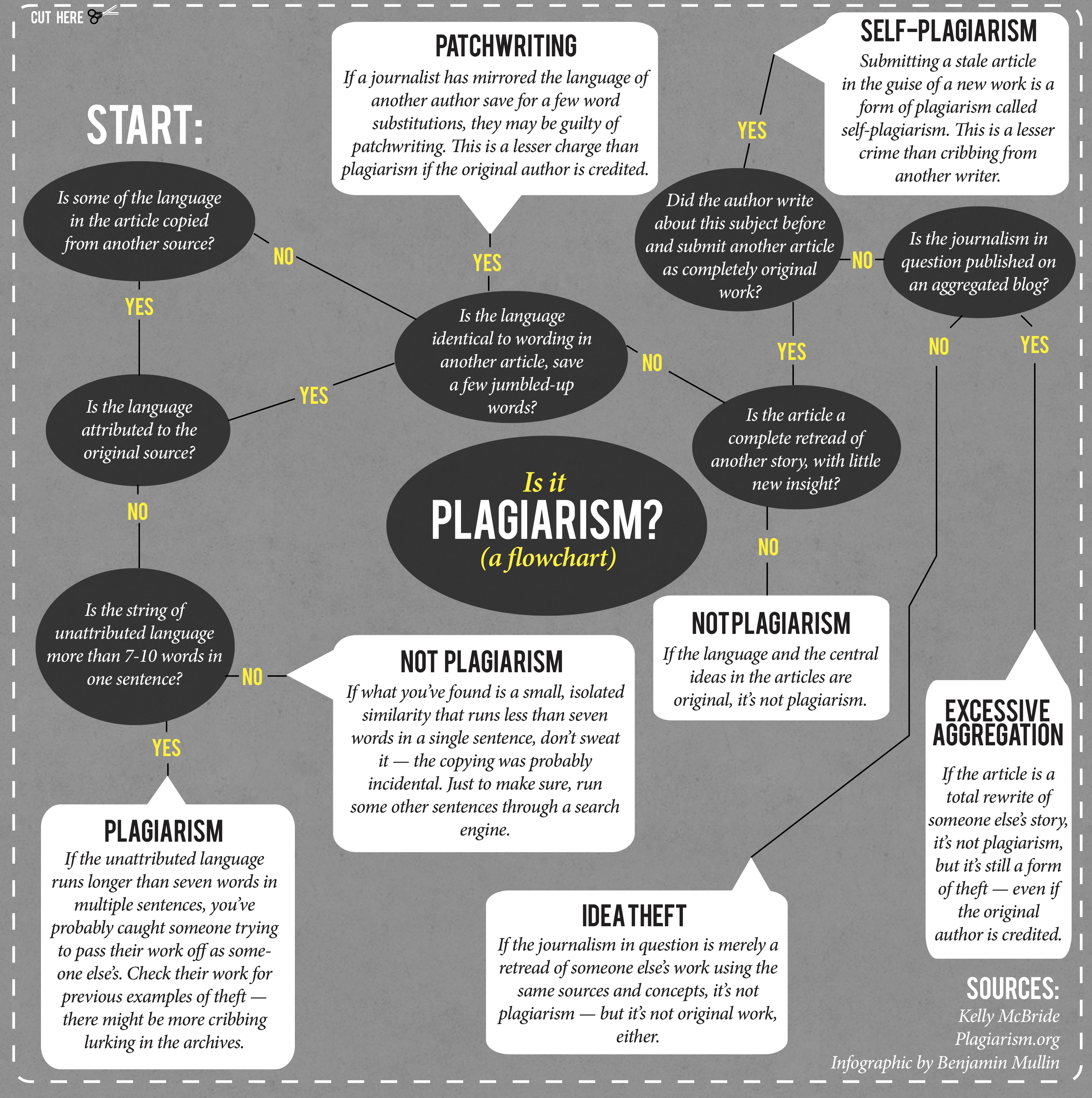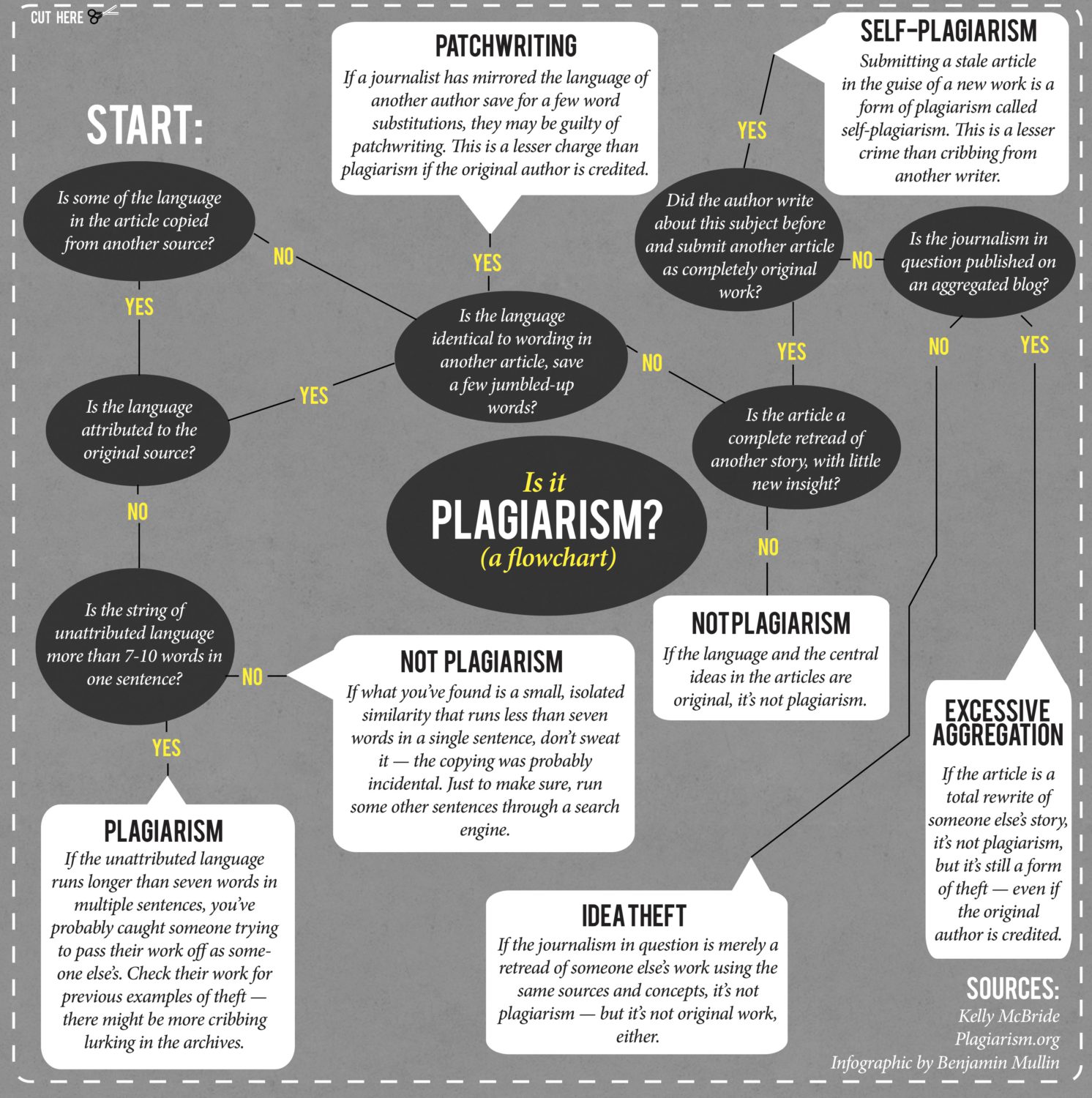If you’re reading this, it happened again. Right now, an editor may be about to issue an apology or a stern rebuttal. Someone’s reputation and body of work is being scrutinized. And a gaggle of self-appointed fact-checkers may be plugging sentence after sentence into Google for any traces of dishonesty. If you’re reading this, a journalist has been accused of what Poynter’s Roy Peter Clark calls “the unoriginal sin”: plagiarism.
Plagiarism is a serious charge. If true, it has the potential to upend a career and mar a journalist’s reputation for life. And yet, in today’s world of aggregated news, plagiarism is an imprecise word that stands for a spectrum of offenses related to unoriginal work. And its severity varies dramatically depending on a variety of circumstances.
See also: Welcome to post-plagiarism America
So before you jump on Twitter to excoriate or defend the media’s latest alleged idea thief, take a minute to go over the following checklist to determine for yourself whether the charges are true. Also, you can cut out or take a screenshot of our plagiarism flowchart for editors.
- Is some of the language in the article unoriginal? Is the central idea of the story unoriginal? In his 2007 dissertation on plagiarism in newspapers, Norman Lewis put forth the following definition of plagiarism: “Using someone else’s words or original ideas without attribution.” This definition, he says, focuses on the act of plagiarism itself and disregards questions of intent. Whether or not the journalist meant to plagiarize is a question best reserved for determining the severity of the crime, not for establishing whether it happened.
- Did the author fail to set off unoriginal language or ideas with quotation marks? Attribution is the opposite of plagiarism, Lewis says, and the clearest indicator of attribution is quotation marks, followed by a citation. The National Summit to Fight Plagiarism and Fabrication put it this way: “Principled professionals credit the work of others, treating others as they would like to be treated themselves.”
- Does the author fail to attribute the work in some other way, such as a paraphrase with credit? Without proper credit, a paraphrase can be used to conceal plagiarism. As Lewis writes, “treating paraphrasing as a plagiarism panacea ignores the fact that a person who cribs from someone else’s work is still cribbing, even if he or she is adept at rewording.”
- Did the author lift more than seven words verbatim from another source? For editors and readers trying to evaluate cases of plagiarism, the 7- to 10-word threshold is a useful guideline, said Kelly McBride, Poynter’s vice president of academic programs. The basic idea is that it’s hard to incidentally replicate seven consecutive words that appear in another author’s work. This is not an absolute rule, however — both McBride and Lewis acknowledge that there’s no easy equation to determine what constitutes plagiarism.
If you answered ‘yes’ to all the questions above, then the accusations being hurled around on Twitter are at least partially right; there’s a legitimate case of unoriginal work masquerading as fresh content. But before you call it plagiarism, remember that there might be a more nuanced word for what’s being discussed. Plagiarism.org lists 10 types of thievery, each with their own degrees of severity, and iThenticate, a plagiarism detection service, lists five additional kinds of lifting in its summary on plagiarism in research.
Here’s a sampling of some unoriginal writing you might run into:
- Self-plagiarism: The outing of Jonah Lehrer, one of the most prominent self-plagiarizers in recent memory, touched off a vigorous debate about whether writers who recycle their own work without acknowledging its unoriginality are guilty of plagiarism or some lesser charge. Poynter vice president and senior scholar Roy Peter Clark, along with New York Times standards editor Phil Corbett says “self-plagiarism” should be called something else; writing before the Lehrer incident, Lewis said self-plagiarism was “less an ethical infraction than a potential violation of ownership rights.” McBride likened Lehrer’s duplicitous duplications to a boyfriend who “recycles the same seemingly spontaneous romantic moments on a succession of dates.” Reuters media critic Jack Shafer argues that you can’t steal from yourself.
- Patchwriting: If the author didn’t copy verbatim, he or she may be guilty of intellectual dishonesty — even if they credit the source. Journalists who craft paraphrases that mirror their source material with the exception of a few jumbled-up words are perpetrators of “patchwriting,” which McBride defines as “relying too heavily on the vocabulary and syntax of the source material.” Clark argues that this is a lesser charge than plagiarism if a writer credits their source. McBride has called it “just as dishonest” as plagiarism.
- Excessive aggregation: Rewriting an entire article, even with proper credit (or an obligatory h/t), is a form of appropriation. Plagiarism.org lists aggregation without original ideas as one of the least severe forms of plagiarism because it does not deceive readers about the source of the information. A sure way to avoid excessive aggregation is to transform the original work by adding value to it, McBride said.
- Idea theft: Relying too heavily on another journalist’s original story ideas and concepts is “quite common in journalism and not intellectually honest,” McBride said. This can occur when a reporter sets out to “match” a story by interviewing the same sources without acknowledging the news was first reported elsewhere.
Still unsure whether something was plagiarized? We made a flowchart to help you decide. Click on the image below for a PDF you can cut out and keep nearby for the next time you come across suspicious copy.

(Benjamin Mullin)







Comments